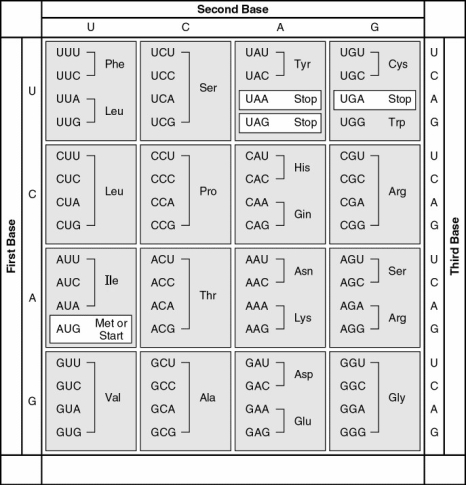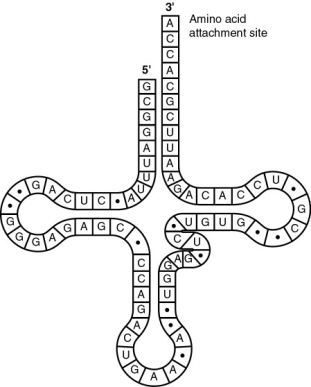A) 3' GGC 5'
B) 5' GGC 3'
C) 5' ACG 3'
D) 5' UGC 3'
E) 3' UGC 5'
Correct Answer

verified
Correct Answer
verified
Multiple Choice
Use the following information to answer the next few questions. A transfer RNA (#1) attached to the amino acid lysine enters the ribosome. The lysine binds to the growing polypeptide on the other tRNA (#2) in the ribosome already. -Which component is not directly involved in translation?
A) mRNA
B) DNA
C) tRNA
D) ribosomes
E) GTP
Correct Answer

verified
Correct Answer
verified
Multiple Choice
Use the following model of a eukaryotic transcript to answer the next few questions. 5' UTR E₁ I₁ E₂ I₂ E₃ I₃ E₄ UTR 3' -Which of the following is a useful feature of introns for this model?
A) They are translated into small polypeptides.
B) They become parts of snRNPs.
C) Each intron has enzymatic properties.
D) Introns allow exon shuffling.
E) Introns protect exon structure.
Correct Answer

verified
Correct Answer
verified
Multiple Choice
When the ribosome reaches a stop codon on the mRNA, no corresponding tRNA enters the A site. If the translation reaction were to be experimentally stopped at this point, which of the following would you be able to isolate?
A) an assembled ribosome with a polypeptide attached to the tRNA in the P site
B) separated ribosomal subunits, a polypeptide, and free tRNA
C) an assembled ribosome with a separated polypeptide
D) separated ribosomal subunits with a polypeptide attached to the tRNA
E) a cell with fewer ribosomes
Correct Answer

verified
Correct Answer
verified
Multiple Choice
What is the function of GTP in translation?
A) GTP energizes the formation of the initiation complex, using initiation factors.
B) GTP hydrolyzes to provide phosphate groups for tRNA binding.
C) GTP hydrolyzes to provide energy for making peptide bonds.
D) GTP supplies phosphates and energy to make ATP from ADP.
E) GTP separates the small and large subunits of the ribosome at the stop codon.
Correct Answer

verified
Correct Answer
verified
Multiple Choice
Which of the following mutations is most likely to cause a phenotypic change?
A) a duplication of all or most introns
B) a large inversion whose ends are each in intergenic regions
C) a nucleotide substitution in an exon coding for a transmembrane domain
D) a single nucleotide deletion in an exon coding for an active site
E) a frameshift mutation one codon away from the 3' end of the nontemplate strand
Correct Answer

verified
Correct Answer
verified
Multiple Choice
The process of translation, whether in prokaryotes or eukaryotes, requires tRNAs, amino acids, ribosomal subunits, and which of the following?
A) polypeptide factors plus ATP
B) polypeptide factors plus GTP
C) polymerases plus GTP
D) SRP plus chaperones
E) signal peptides plus release factor
Correct Answer

verified
Correct Answer
verified
Multiple Choice
Which small-scale mutation would be most likely to have a catastrophic effect on the functioning of a protein?
A) a base substitution
B) a base deletion near the start of a gene
C) a base deletion near the end of the coding sequence, but not in the terminator codon
D) deletion of three bases near the start of the coding sequence, but not in the initiator codon
E) a base insertion near the end of the coding sequence, but not in the terminator codon
Correct Answer

verified
Correct Answer
verified
Multiple Choice
The following questions refer to this table of codons.
 -A peptide has the sequence NH₂-phe-pro-lys-gly-phe-pro-COOH. Which of the following sequences in the coding strand of the DNA could code for this peptide?
-A peptide has the sequence NH₂-phe-pro-lys-gly-phe-pro-COOH. Which of the following sequences in the coding strand of the DNA could code for this peptide?
A) 3' UUU-CCC-AAA-GGG-UUU-CCC
B) 3' AUG-AAA-GGG-TTT-CCC-AAA-GGG
C) 5' TTT-CCC-AAA-GGG-TTT-CCC
D) 5' GGG-AAA-TTT-AAA-CCC-ACT-GGG
E) 5' ACT-TAC-CAT-AAA-CAT-TAC-UGA
Correct Answer

verified
Correct Answer
verified
Multiple Choice
Which of the following types of mutation, resulting in an error in the mRNA just after the AUG start of translation, is likely to have the most serious effect on the polypeptide product?
A) a deletion of a codon
B) a deletion of two nucleotides
C) a substitution of the third nucleotide in an ACC codon
D) a substitution of the first nucleotide of a GGG codon
E) an insertion of a codon
Correct Answer

verified
Correct Answer
verified
Multiple Choice
Which of the following nucleotide triplets best represents a codon?
A) a triplet separated spatially from other triplets
B) a triplet that has no corresponding amino acid
C) a triplet at the opposite end of tRNA from the attachment site of the amino acid
D) a triplet in the same reading frame as an upstream AUG
E) a sequence in tRNA at the 3' end
Correct Answer

verified
Correct Answer
verified
Multiple Choice
 -The tRNA shown in the figure has its 3' end projecting beyond its 5' end. What will occur at this 3' end?
-The tRNA shown in the figure has its 3' end projecting beyond its 5' end. What will occur at this 3' end?
A) The codon and anticodon complement one another.
B) The amino acid binds covalently.
C) The excess nucleotides (ACCA) will be cleaved off at the ribosome.
D) The small and large subunits of the ribosome will attach to it.
E) The 5' cap of the mRNA will become covalently bound.
Correct Answer

verified
Correct Answer
verified
Multiple Choice
The following question refers to this figure of a simple metabolic pathway:
 -A mutation results in a defective enzyme A. Which of the following would be a consequence of that mutation?
-A mutation results in a defective enzyme A. Which of the following would be a consequence of that mutation?
A) an accumulation of A and no production of B and C
B) an accumulation of A and B and no production of C
C) an accumulation of B and no production of A and C
D) an accumulation of B and C and no production of A
E) an accumulation of C and no production of A and B
Correct Answer

verified
Correct Answer
verified
Multiple Choice
In the structural organization of many eukaryotic genes, individual exons may be related to which of the following?
A) the sequence of the intron that immediately precedes each exon
B) the number of polypeptides making up the functional protein
C) the various domains of the polypeptide product
D) the number of restriction enzyme cutting sites
E) the number of start sites for transcription
Correct Answer

verified
Correct Answer
verified
Multiple Choice
A frameshift mutation could result from
A) a base insertion only.
B) a base deletion only.
C) a base substitution only.
D) deletion of three consecutive bases.
E) either an insertion or a deletion of a base.
Correct Answer

verified
Correct Answer
verified
Multiple Choice
RNA polymerase in a prokaryote is composed of several subunits. Most of these subunits are the same for the transcription of any gene, but one, known as sigma, varies considerably. Which of the following is the most probable advantage for the organism of such sigma switching?
A) It might allow the transcription process to vary from one cell to another.
B) It might allow the polymerase to recognize different promoters under certain environmental conditions.
C) It could allow the polymerase to react differently to each stop codon.
D) It could allow ribosomal subunits to assemble at faster rates.
E) It could alter the rate of translation and of exon splicing.
Correct Answer

verified
Correct Answer
verified
Multiple Choice
A particular triplet of bases in the template strand of DNA is 5' AGT 3'. The corresponding codon for the mRNA transcribed is
A) 3' UCA 5'.
B) 3' UGA 5'.
C) 5' TCA 3'.
D) 3' ACU 5'.
E) either UCA or TCA, depending on wobble in the first base.
Correct Answer

verified
Correct Answer
verified
Multiple Choice
During splicing, which molecular component of the spliceosome catalyzes the excision reaction?
A) protein
B) DNA
C) RNA
D) lipid
E) sugar
Correct Answer

verified
Correct Answer
verified
Multiple Choice
Use this representation to answer the following questions. DNA template strand 5' ____________________________ 3' DNA complementary strand 3' ____________________________ 5' -Given the locally unwound double strand above, in which direction does the RNA polymerase move?
A) 3' → 5' along the template strand
B) 5' → 3' along the template strand
C) 3' �→ 5' along the complementary strand
D) 5' → 3' along the complementary strand
E) 5' → 3' along the double-stranded DNA
Correct Answer

verified
Correct Answer
verified
Multiple Choice
Garrod hypothesized that "inborn errors of metabolism" such as alkaptonuria occur because
A) metabolic enzymes require vitamin cofactors, and affected individuals have significant nutritional deficiencies.
B) enzymes are made of DNA, and affected individuals lack DNA polymerase.
C) many metabolic enzymes use DNA as a cofactor, and affected individuals have mutations that prevent their enzymes from interacting efficiently with DNA.
D) certain metabolic reactions are carried out by ribozymes, and affected individuals lack key splicing factors.
E) genes dictate the production of specific enzymes, and affected individuals have genetic defects that cause them to lack certain enzymes.
Correct Answer

verified
Correct Answer
verified
Showing 21 - 40 of 83
Related Exams